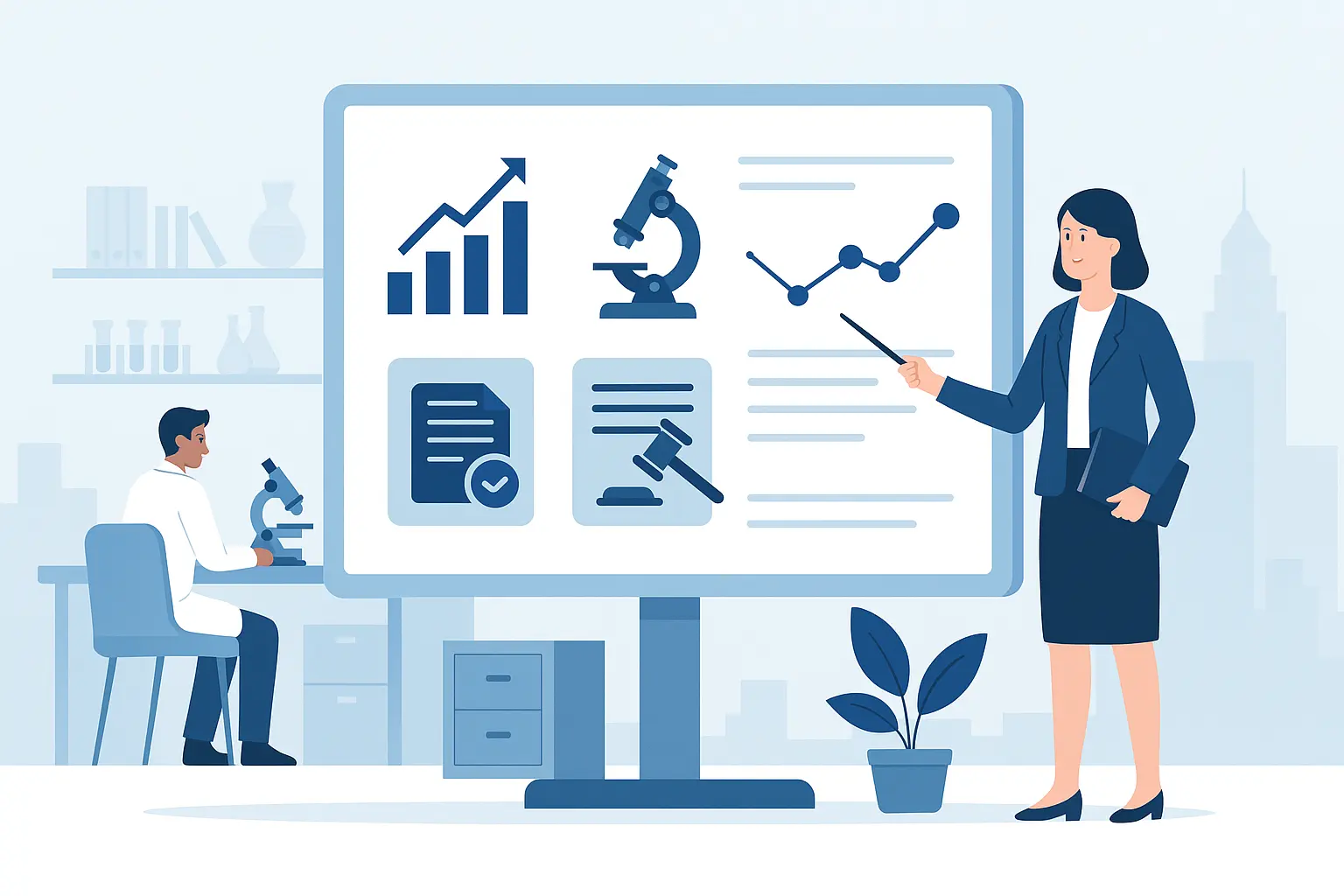Industry Insights
Tips for Laboratory Billing Reimbursement Challenges
October 3, 2025
Editor’s Note: This article was originally published on March 12, 2024.
Running an independent pathology practice or clinical lab comes with a list of challenges, and getting proper payment for services rendered is typically high on that list.
To help ensure that medical labs get reimbursed correctly for their services, Clinical Lab Products (CLP) recently published an article on the subject. The article, linked below, features tips and best practices from leading lab revenue cycle management (lab RCM) companies on how to streamline the laboratory billing process and navigate what has become a very tricky reimbursement landscape.
CLP Article: 6 Best Practices for More Successful Laboratory Reimbursement
As a LIS company with an all-in-one informatics platform that includes comprehensive laboratory billing solutions embedded within the advanced application, we’re honored that CLP chose to include comments from Lab Billing Specialist Gayane Haroutyunyan in this very important and timely article. As is often the case, not all of Gayane’s insights made it into the final article, so we’re sharing the full transcript of her CLP interview here for the benefit of our lab partners and the broader lab community.
If after reading this article, you have specific questions about laboratory billing or more generally about what type of billing software for labs would make the most sense for your business, please feel free to contact us and set up a call with a lab billing specialist.
Q & A with a Lab Billing Expert
The following is a transcript of an interview conducted by CLP reporter Ann H. Carlson with Lab Billing Specialist Gayane Haroutyunyan.
What does the current lab revenue cycle management reimbursement landscape look like in 2024?
The Medicare Physician Fee Schedule Final Rule released recently by CMS has outlined that. The 2024 Conversion Factor is $32.74, a roughly 3.4% decrease from the 2023 CF. Overall payments for pathologists are expected to decrease by 2%, and payments for independent labs are projected to drop by 1%. Analysis from the College of American Pathologists (CAP) states that the reductions are primarily due to the addition of the E/M add-on code G2211 and a 1.25% decrease in payments issued by the Consolidated Appropriations Act.
What are the biggest laboratory billing reimbursement challenges and their causes? How do these challenges affect medical labs currently?
The biggest challenge that laboratories face is compliance regulations that are ever-changing in the industry. Keeping up to date with them is difficult for both small and large-scale laboratories. Consistent introduction of new coding and/or lab billing guidelines and requirements often devastates reimbursement rates. The staffing shortage issues and high turnover rates that most laboratories experience also contribute to reimbursement challenges.
Industry Insights: Regulators Are Rewriting HIPAA - Survival Guide for Clinical & Pathology Labs
Are there any positives about the current reimbursement situation for labs?
Yes, the biggest positive is that coding and lab billing workflows increasingly rely on automation and rules’ utilities of laboratory software systems. And, fortunately, some lab RCM software products can accommodate this trend and deliver appropriate automation functionalities for the laboratory billing process right out of the box.
Discover More: Laboratory Billing Automation - Boosting Efficiency & Clean Claim Rates

What types of testing are consistently being reimbursed at a sustainable rate for labs? Which kinds are on shakier ground?
The reimbursement rates for laboratory tests can vary based on factors such as geographic location, payer policies, and specific test codes. However, certain types of testing are often considered essential and may have more consistent and sustainable reimbursement rates. Some categories of testing that are typically reimbursed at a reasonable rate include:
- Basic and Common Laboratory Tests
- Diagnostic Imaging Tests
- Microbiology Tests
- Clinical Chemistry Tests
- Hematology Tests
- Pathology Tests
How has legislation or the lack of it (e.g., SALSA), affected the reimbursement landscape?
Legislation, in general, can significantly impact the reimbursement rates for laboratories. Changes in healthcare laws, regulations, and policies can influence how reimbursement is determined, what services are eligible for reimbursement, and the rates at which providers are compensated. The absence of specific legislation addressing reimbursement issues may also leave gaps or uncertainties in the reimbursement process. Some ways legislation or the lack of it could affect the reimbursement landscape include:
- Coverage and Eligibility
- Payment Rates
- Compliance Requirements
- Coding and Documentation Standards
- Fraud and Abuse Prevention
- Quality Measures
Discover More: The LigoLab Difference: Demonstrating the Power of RCM Automation in the Clinical Laboratory
What is the status of SALSA? Does it seem to be gaining traction? What is being done in the industry to advance this legislation? How can labs get involved?
A little over a year ago, a positive change emerged in the legislative landscape for clinical laboratories. The House and Senate introduced the Saving Access to Laboratory Services Act (SALSA).
SALSA would provide the Centers for Medicare and Medicaid Services (CMS) new authority to obtain private market data via statistically valid sampling from all laboratory segments for the widely available test services where previous data collection was inadequate.
If successful, this bill would prevent drastic reimbursement cuts for laboratories that were originally scheduled for 2023 and the following years. Despite extensive support, Congress has yet to pass the bill. However, Congress did approve a freeze on Medicare’s Clinical Laboratory Fee Schedule (CLFS) rate cut for 2023 as well as a delay in the reporting requirements.
What are some common mistakes laboratories make regarding lab billing reimbursement? How can these be avoided?
One common mistake laboratories make in the context of lab billing reimbursement is inefficient management of denials and appeals. This laboratory billing process requires thorough monitoring and analysis of trends to identify why claims are denied. By understanding these patterns, laboratories can address denials more effectively and resubmit corrected claims promptly, enhancing their chances of reimbursement.
Another significant oversight is the underutilization of automation in claim submission, especially for standard test cases. Automation streamlines the submission process, making it quicker and more accurate. Without this, laboratories risk the inefficient use of staff resources, leading to delayed submissions and potentially reduced reimbursement rates.
Additionally, laboratories often make errors in coding and billing. Inaccurate or outdated coding can lead to claim rejections or denials. Regular training and updates on coding standards are essential to avoid these mistakes.
Poor documentation is another common pitfall. Detailed and accurate documentation of tests and procedures is crucial for claim approval. Inadequate documentation can lead to claim denials, as insurers may not find sufficient justification for the tests performed.
Lastly, failing to stay updated with payer policies can result in non-compliance and subsequent claim denials. Laboratories need to stay informed about changes in insurance policies and regulations to ensure their lab billing practices align with current requirements.
To avoid these mistakes, laboratories should invest in regular staff training, utilize the latest lab billing software and automated RCM tools, maintain meticulous documentation, and stay abreast of evolving payer policies and coding standards.
Industry Insights: Navigating the Coding Minefield - Labs Struggle with RCM Rejections Amid Rising Scrutiny from Payers
What are the best practices laboratories should be following to help them continue to get reimbursed for established tests and, more importantly, new ones?
Best practices for laboratories should include a commitment to addressing compliance regulations, leaving no denials unattended, and employing coding/billing automation in all areas of operations.

What does the reimbursement landscape look like in the next 5 or so years?
It is difficult to make predictions here because some currently pending legislation concerning laboratory billing reimbursement rates paints a positive and encouraging picture, but the declines in reimbursement rates that the industry has experienced over the last decades prove to be contradictory to this.
Looking forward, several key factors could shape the reimbursement landscape:
Healthcare Policy Changes: Any new healthcare legislation or amendments to existing laws could significantly impact reimbursement rates. Changes in government policies, especially those related to Medicare and Medicaid, are particularly influential.
Technological Advancements: The integration of advanced technologies like artificial intelligence (AI) and automation in the laboratory billing process may influence reimbursement policies. These technologies could lead to more efficient and cost-effective operations, potentially affecting how services are valued and reimbursed.
Shift to Value-Based Care: The ongoing shift from fee-for-service to value-based care models in healthcare could reshape reimbursement strategies. Laboratories that demonstrate cost-effectiveness and high-quality outcomes might be favorably positioned in such a scenario.
Market Consolidation: The trend of consolidation in the healthcare industry, including in the laboratory sector, may impact reimbursement rates. Larger entities may have greater negotiating power with payers, which could influence overall market rates.
Public Health Trends: The demand for laboratory services, influenced by public health trends such as the emergence of new diseases or the focus on preventive care, can also affect reimbursement policies.
White Paper: Maximizing Your Lab’s Profitability - The Case for In-House Lab Billing
More Helpful Laboratory Billing Resources
If you’d like more information on the current state of laboratory revenue cycle management and what RCM tools are available to help your testing organization reduce denials and maximize net collections, you’re invited to check out the following lab billing resources.
Laboratory Billing 101: The Differences Between In-House Billing and Outsourced Billing Services
Is Your RCM Software Vendor Putting Your Lab’s Needs First?
Reimbursement cuts are real - but so are smarter solutions.
Contact LigoLab today for a personalized consultation with a lab billing expert and learn how automation, compliance tools, and integrated RCM tools can future-proof your laboratory.






